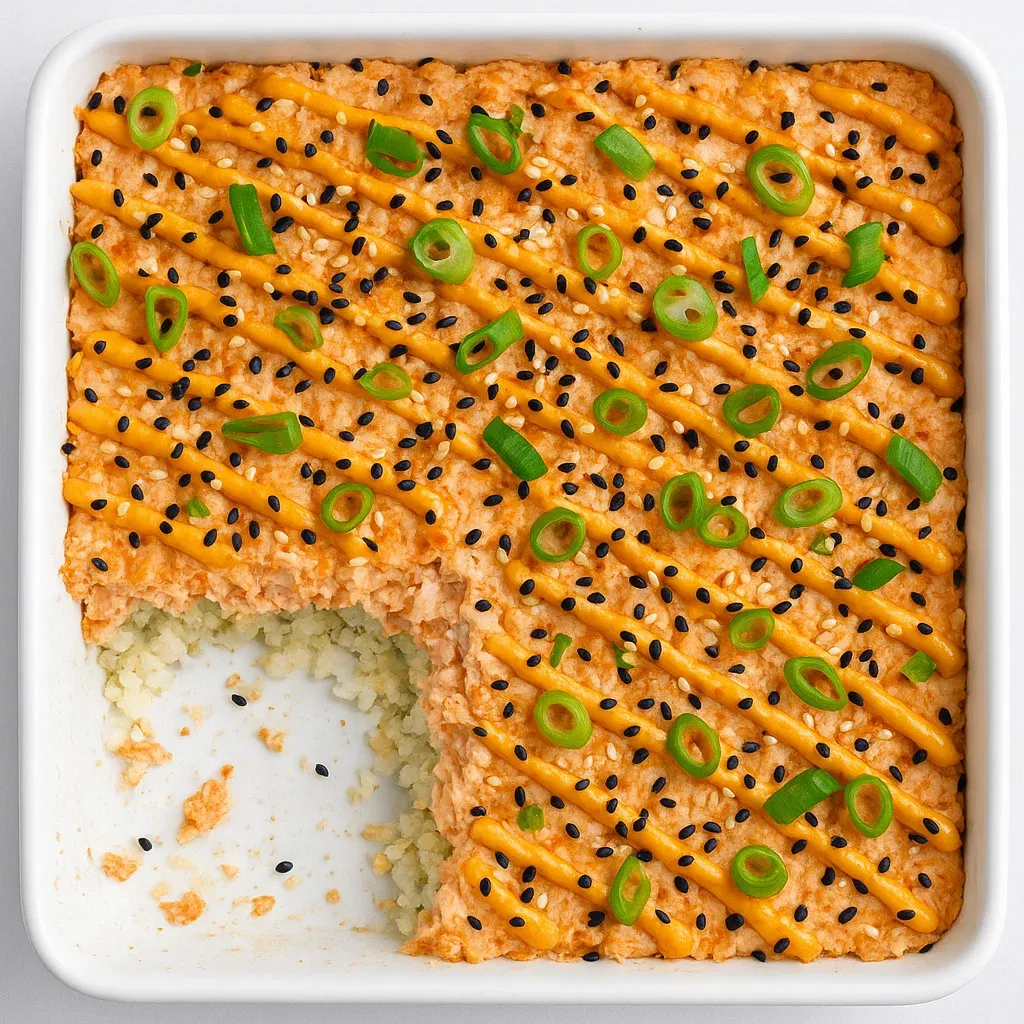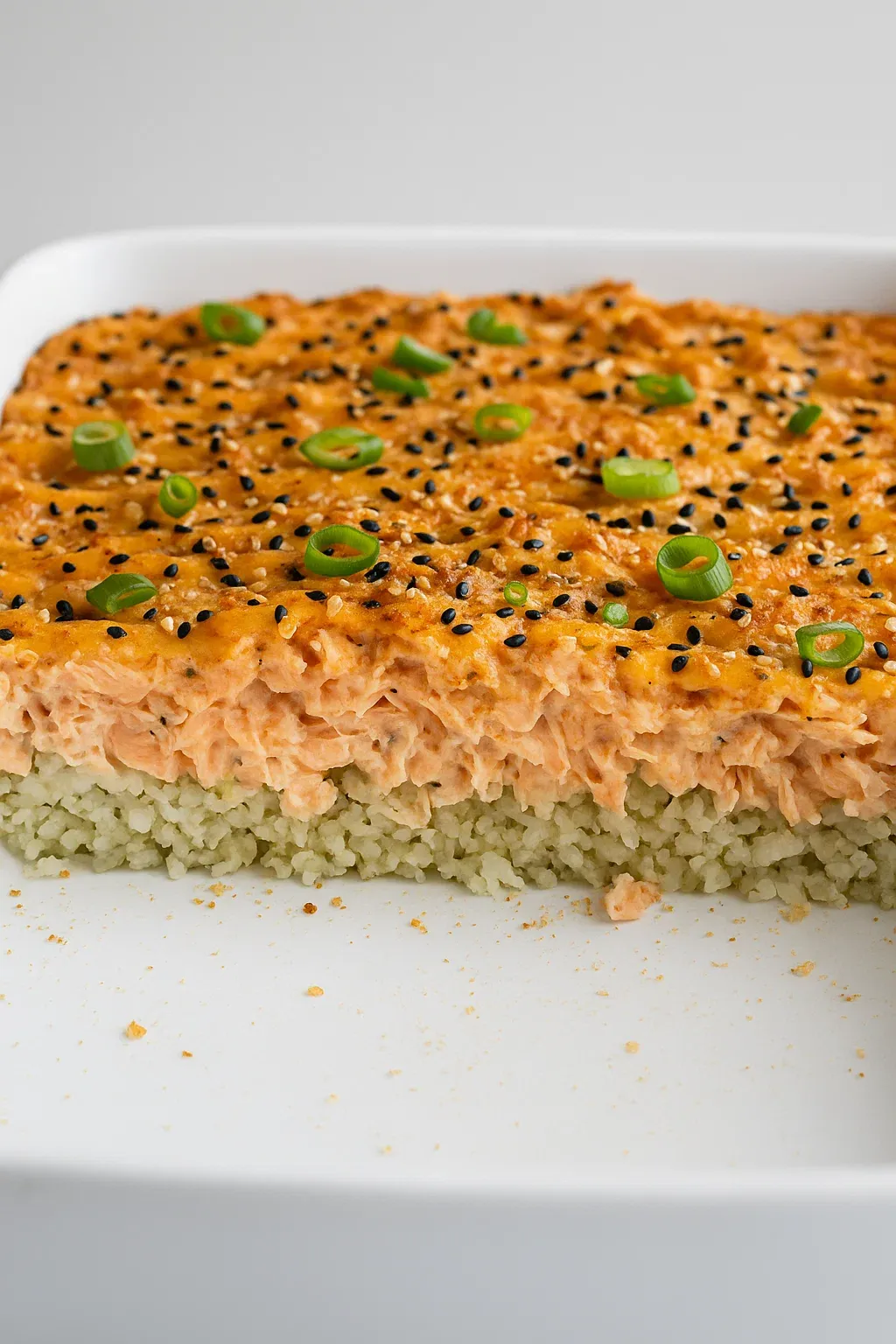 Pin it
Pin it
This salmon sushi bake combines the fresh flavors of sushi with the comfort of a casserole, bringing restaurant quality to your dinner table without the fuss of rolling traditional sushi. The layers of seasoned sushi rice topped with a rich salmon mixture create a dish that's impressive yet surprisingly simple to prepare.
I first made this for a casual dinner party when I wanted to impress without spending hours in the kitchen. My guests were scraping the dish clean and asking for the recipe before dessert was even served. Now it's my go to when I want something special that feels indulgent but comes together with minimal effort.
Ingredients
- Sushi rice: Provides the perfect sticky texture and neutral base for the flavors to shine
- Japanese mayonnaise: Offers a rich tanginess that regular mayo simply cannot match
- Imitation crab meat: Brings sweetness and that classic California roll flavor without breaking the budget
- Cream cheese: Creates a luscious creaminess that binds everything together perfectly
- Sriracha: Adds just the right amount of heat that can be adjusted to your preference
- Furikake: This Japanese seasoning blend adds authentic flavor with seaweed and sesame undertones
- Salmon fillets: Use fresh high quality salmon for the best flavor and texture
How To Make Salmon Sushi Bake
- Prepare The Rice:
- Rinse the sushi rice under cold water until the water runs clear to remove excess starch. Cook according to rice cooker instructions with the measured water. Once cooked, gently fold in the seasoned rice vinegar using a cutting motion to avoid mashing the grains. Spread on a baking sheet to cool slightly while maintaining its sticky texture.
- Season And Cook The Salmon:
- Pat the salmon dry with paper towels to ensure proper browning. Season generously with salt, pepper, and garlic powder on all sides. Bake at 400°F for 15 to 20 minutes until the internal temperature reaches 145°F. The salmon should flake easily with a fork but remain moist. Allow to cool slightly before handling.
- Create The Filling:
- In a large bowl, combine the cooked salmon broken into chunks with chopped imitation crab, Japanese mayonnaise, softened cream cheese, sriracha, and soy sauce. Mix thoroughly but gently to maintain some texture in the salmon rather than creating a paste. Taste and adjust seasonings as needed.
- Assemble The Layers:
- Press the cooled sushi rice into an even layer in a 9x13 baking dish using slightly dampened hands to prevent sticking. The layer should be compact but not squashed. Sprinkle the furikake evenly across the rice to create a flavorful foundation. Spread the salmon mixture on top in an even layer reaching all edges of the dish.
- Broil And Garnish:
- Place the assembled dish under the broiler for about 4 minutes until the top develops a slight golden color and the cream cheese begins to bubble. Remove from the oven and immediately drizzle with spicy mayo, sprinkle with green onions and sesame seeds for a professional finish that adds both flavor and visual appeal.
 Pin it
Pin it
The Japanese mayonnaise makes an incredible difference in this recipe that I cannot overstate. I once tried to substitute regular mayonnaise when I ran out of Kewpie brand, and while still delicious, it lacked that distinctive tangy richness that makes this dish special. My family immediately noticed the difference and now I keep extra Japanese mayo on hand specifically for this recipe.
Perfect Rice Technique
The foundation of any good sushi dish including this bake is properly prepared rice. After cooking, never refrigerate the rice before assembling the dish as cold rice becomes hard and loses its essential stickiness. The folding in of seasoned rice vinegar should be done with a cutting motion rather than stirring to maintain the integrity of each grain while distributing flavor. If you find your rice too wet, simply leave it uncovered for 5 to 10 minutes to allow excess moisture to evaporate before assembling.
 Pin it
Pin it
Make It Your Own
This versatile dish welcomes creative variations. Try adding a thin layer of wasabi mayo between the rice and salmon mixture for heat lovers. Substitute smoked salmon for a different flavor profile that requires no cooking. For a vegetarian version, replace the seafood with avocado, cucumber, and sautéed shiitake mushrooms seasoned with the same spices. The recipe adapts beautifully to what you have on hand or dietary preferences without losing its essential character.
Storage And Reheating
Leftovers keep remarkably well in an airtight container in the refrigerator for up to two days. To reheat, cover with foil and warm in a 325°F oven for about 15 minutes until heated through. Avoid microwaving which can make the rice tough and rubbery. For the best texture when serving leftovers, add fresh toppings like avocado, cucumber, and an extra drizzle of spicy mayo after reheating to bring back the freshness factor.
Serving Suggestions
Serve this sushi bake with small squares of nori for wrapping, creating a fun interactive dining experience. Provide small bowls of soy sauce, wasabi, and pickled ginger on the side for authentic sushi condiments. A simple miso soup makes an excellent starter to complete the Japanese inspired meal. For a more substantial spread, include edamame, cucumber salad with rice vinegar dressing, and tempura vegetables for a complete sushi restaurant experience at home.
Frequently Asked Questions
- → What type of rice works best for this dish?
Sushi rice, such as Calrose or another short-grain variety, is best due to its sticky texture that holds the layers together nicely.
- → Can I use fresh crab instead of imitation crab?
Yes, fresh crab meat works wonderfully in this dish. It adds a luxurious, natural seafood flavor to the creamy filling.
- → What is furikake, and is it necessary?
Furikake is a Japanese seasoning blend typically including sesame seeds, seaweed, and dried fish. It enhances the flavor, but you can skip it or substitute with toasted sesame seeds if needed.
- → How do I adjust the spice level?
You can reduce or increase the sriracha in the filling and toppings based on your heat preference. Lime juice can balance spiciness too.
- → Is this dish gluten-free?
Most ingredients are naturally gluten-free, but ensure you use gluten-free soy sauce to make the dish suitable for a gluten-free diet.
- → What are the best pairings for this dish?
Serve it with roasted seaweed sheets, diced cucumbers, avocado slices, and drizzle with unagi sauce or more spicy mayo for a complete meal.
